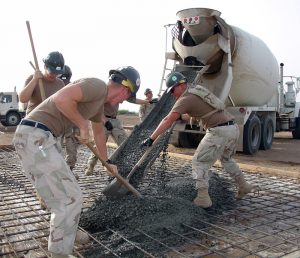“Everything that can be invented has been invented.” This quote has been mistakenly attributed to Charles Holland Duell commissioner of the United States Patent and Trademark Office from 1898 to 1901.
The advance of technology has grown exponentially since then and some major inventions like the personal computer have transformed our lives to such an extent that we have entered a new “age” i.e. the Information Age. Not all inventions/discoveries have created a new “age” but many have had a major impact on civilization and one ancient discovery may have almost as big an impact in the near future as it had thousands of years ago. ~ Tim McMahon, editor
Technology Turns to Bacteria to Create Self-Healing Concrete
History

Around 700 BC Bedouins occupying a series of oases in what is now Southern Syria and Northern Jordan built kilns to supply mortar for the construction of rubble-wall houses, concrete floors, and most importantly underground waterproof cisterns. These cisterns were kept secret and were one of the reasons they were able to thrive in the desert and some of these structures are still visible today.
One of the reasons the Roman Empire thrived was their extensive use of concrete. Roman concrete (or opus caementicium) was made from quicklime, volcanic ash and pumice. Its widespread use in many Roman structures, sparked the Roman Architectural Revolution, freed Roman construction from the restrictions of stone and brick material and allowed for revolutionary new designs in terms of both structural complexity and dimension.
Unfortunately, during the Middle Ages, the use of concrete was largely forgotten. It wasn’t until 1756 when British engineer John Smeaton built a Lighthouse in Devon, England using hydraulic lime, combined with pebbles and powdered brick as aggregate that modern concrete was born.
In 1824, Joseph Aspdin patented a method for producing Portland cement and reinforced concrete was invented in 1849 by Joseph Monier. In 1889 the first concrete reinforced bridge was built, and the first large concrete dams were Boulder Dam (aka. Hoover Dam) and Grand Coulee Dam built in the 1930’s and ’40’s.
Advantages and Disadvantages
In addition to its versatility and mold-ability, concrete’s major advantage is that it is extremely strong in compression. However, it is weak in tension as the cement holding the aggregate in place can crack, allowing the structure to fail. The addition of steel bars, steel fibers, glass fibers, or plastic fibers to create “reinforced concrete” helped overcome this weakness.
The major remaining vulnerability of concrete was that as it aged it dried out and eventually it began to crumble. This meant that it would need to be repaired or replaced periodically.
Modern Advances
But a recent invention/discovery called “BioConcrete” or “Self-Healing Concrete” could revolutionize the use of concrete and eliminate this remaining vulnerability. This new concrete contains a special strain of bacteria that can lie dormant for up to 200 years. But as moisture enters through new cracks, it activates the bacteria which then begin to secrete limestone which seals the cracks. Researchers are also working on a liquid sealant that can do the same thing for conventional concrete. This is a major advance for concrete that could save billions of dollars in construction and repair costs.
https://youtu.be/laqACVY1U_k

